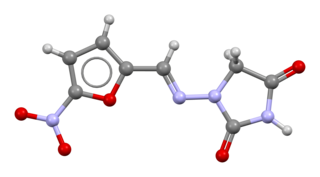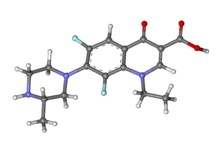
Ciprofloxacin is a fluoroquinolone antibiotic used to treat a number of bacterial infections. This includes bone and joint infections, intra-abdominal infections, certain types of infectious diarrhea, respiratory tract infections, skin infections, typhoid fever, and urinary tract infections, among others. For some infections it is used in addition to other antibiotics. It can be taken by mouth, as eye drops, as ear drops, or intravenously.

A urinary tract infection (UTI) is an infection that affects a part of the urinary tract. When it affects the lower urinary tract it is known as a bladder infection (cystitis) and when it affects the upper urinary tract it is known as a kidney infection (pyelonephritis). Symptoms from a lower urinary tract infection include pain with urination, frequent urination, and feeling the need to urinate despite having an empty bladder. Symptoms of a kidney infection include fever and flank pain usually in addition to the symptoms of a lower UTI. Rarely the urine may appear bloody. In the very old and the very young, symptoms may be vague or non-specific.

Levofloxacin, sold under the brand name Levaquin among others, is an antibiotic medication. It is used to treat a number of bacterial infections including acute bacterial sinusitis, pneumonia, H. pylori, urinary tract infections, chronic prostatitis, and some types of gastroenteritis. Along with other antibiotics it may be used to treat tuberculosis, meningitis, or pelvic inflammatory disease. Use is generally recommended only when other options are not available. It is available by mouth, intravenously, and in eye drop form.

Nitrofurantoin is an antibacterial medication of the nitrofuran class used to treat urinary tract infections, although it is not as effective for kidney infections. It is taken by mouth.

Cefalexin, also spelled cephalexin, is an antibiotic that can treat a number of bacterial infections. It kills gram-positive and some gram-negative bacteria by disrupting the growth of the bacterial cell wall. Cefalexin is a β-lactam antibiotic within the class of first-generation cephalosporins. It works similarly to other agents within this class, including intravenous cefazolin, but can be taken by mouth.

Cefixime, sold under the brand name Suprax among others, is an antibiotic medication used to treat a number of bacterial infections. These infections include otitis media, strep throat, pneumonia, urinary tract infections, gonorrhea, and Lyme disease. For gonorrhea typically only one dose is required. In the United States it is a second-line treatment to ceftriaxone for gonorrhea. It is taken by mouth.

Pyelonephritis is inflammation of the kidney, typically due to a bacterial infection. Symptoms most often include fever and flank tenderness. Other symptoms may include nausea, burning with urination, and frequent urination. Complications may include pus around the kidney, sepsis, or kidney failure.

Phenazopyridine is a medication which, when excreted by the kidneys into the urine, has a local analgesic effect on the urinary tract. It is often used to help with the pain, irritation, or urgency caused by urinary tract infections, surgery, or injury to the urinary tract.

Cefaclor, sold under the trade name Ceclor among others, is a second-generation cephalosporin antibiotic used to treat certain bacterial infections such as pneumonia and infections of the ear, lung, skin, throat, and urinary tract. It is also available from other manufacturers as a generic.

Norfloxacin, sold under the brand name Noroxin among others, is an antibiotic that belongs to the class of fluoroquinolone antibiotics. It is used to treat urinary tract infections, gynecological infections, inflammation of the prostate gland, gonorrhea and bladder infection. Eye drops were approved for use in children older than one year of age.

Sultamicillin, sold under the brand name Unasyn among others, is an oral form of the penicillin antibiotic combination ampicillin/sulbactam. It is used for the treatment of bacterial infections of the upper and lower respiratory tract, the kidneys and urinary tract, skin and soft tissues, among other organs. It contains esterified ampicillin and sulbactam.

Sulfadiazine is an antibiotic. Used together with pyrimethamine, a dihydrofolate reductase inhibitor, it is the treatment of choice for toxoplasmosis, which is caused by a protozoan parasite. It is a second-line treatment for otitis media, prophylaxis of rheumatic fever, chancroid, chlamydia, and infections by Haemophilus influenzae. It is also used as adjunct therapy for chloroquine-resistant malaria and several forms of bacterial meningitis. It is taken by mouth. Sulfadiazine is available in multiple generic tablets of 500 mg. For urinary tract infections, the usual dose is 4 to 6 grams daily in 3 to 6 divided doses.

Cinoxacin is a quinolone antibiotic that has been discontinued in the U.K. as well the United States, both as a branded drug or a generic. The marketing authorization of cinoxacin has been suspended throughout the EU.

Temafloxacin is a fluoroquinolone antibiotic drug which was withdrawn from sale in the United States shortly after its approval in 1992 because of serious adverse effects resulting in three deaths. It is not marketed in Europe.

Bacteriuria is the presence of bacteria in urine. Bacteriuria accompanied by symptoms is a urinary tract infection while that without is known as asymptomatic bacteriuria. Diagnosis is by urinalysis or urine culture. Escherichia coli is the most common bacterium found. People without symptoms should generally not be tested for the condition. Differential diagnosis include contamination.

Pivmecillinam (INN) or amdinocillin pivoxil is an orally active prodrug of mecillinam, an extended-spectrum penicillin antibiotic. Pivmecillinam is the pivaloyloxymethyl ester of mecillinam.
Mirabegron, sold under the brand name Myrbetriq among others, is a medication used to treat overactive bladder. Its benefits are similar to antimuscarinic medication such as solifenacin or tolterodine. It is taken by mouth.

Finafloxacin (Xtoro) is a fluoroquinolone antibiotic. In the United States, it is approved by the Food and Drug Administration to treat acute otitis externa caused by the bacteria Pseudomonas aeruginosa and Staphylococcus aureus.

Vaborbactam (INN) is a non-β-lactam β-lactamase inhibitor discovered by Rempex Pharmaceuticals, a subsidiary of The Medicines Company. While not effective as an antibiotic by itself, it restores potency to existing antibiotics by inhibiting the β-lactamase enzymes that would otherwise degrade them. When combined with an appropriate antibiotic it can be used for the treatment of gram-negative bacterial infections.

Vibegron, sold under the brand name Gemtesa, is a medication for the treatment of overactive bladder. Vibegron is a selective beta-3 adrenergic receptor agonist.




















